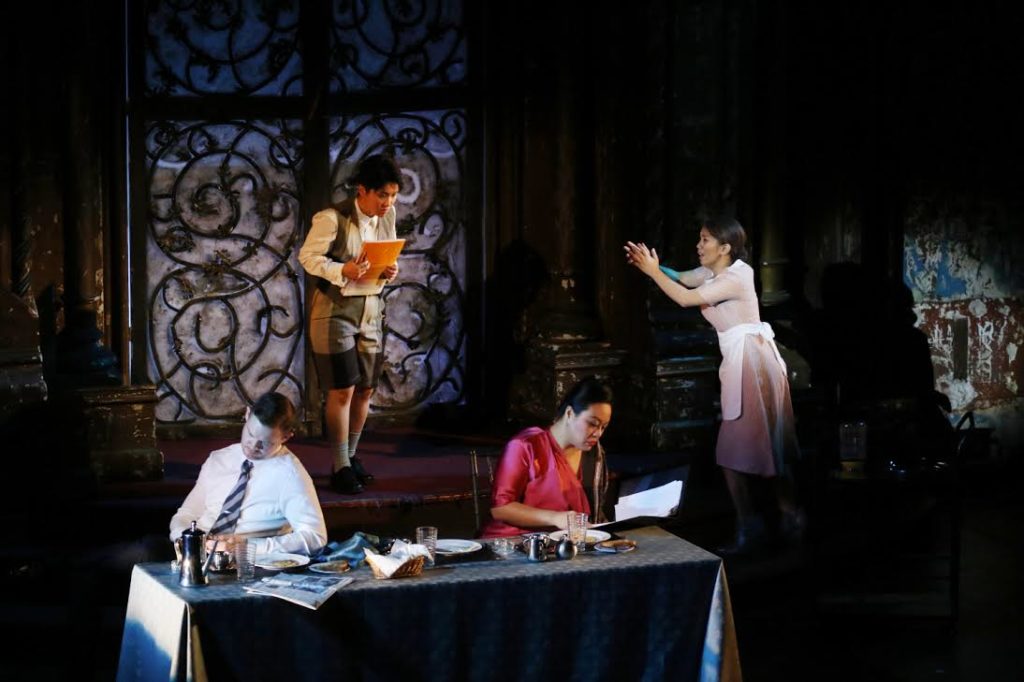
Hong Kong Arts Development Council & Asia Society 2019 Review: Mila
Candace Chong & Eli Marshall’s Stunning Chamber Opera Features Star Turn from Stefanie Quintin
By David Salazar(Credit: Ellen Wallop/Asia Society)
Since its inception, opera has shifted its focus from gods and kings to the more common and middle class folk. But the domestic worker, while making appearances, is almost never at the core of its stories.
“Mila,” an opera presented by the Hong Kong Arts Development Council and the Asia Society on Dec. 7, 2019 in New York, makes that shift with potent effect.
An Unhappy Family
The Chamber Opera, written by librettist Candace Chong and composer Eli Marshall, centers on a family of three living in Hong Kong and Mila, the 13th domestic worker that the family has employed. She’s new and is clearly trying her utmost to impress her employers, but they can’t seem to find satisfaction in anything. They complain about ham tasting like a flip flop and toast as “hard as a chopping board.” They also don’t like one another very much and their marriage seems to be imploding by the second.
Stuck in the middle of all this is their young teenager boy who is feeling the pressure of his studies; as Mila notes, he has some suicidal tendencies, having poured “bleach in his coke” and even tried to “drown himself in a bucket.” But, per Mila, the parents don’t see any of this and her fears for the young boy connect her to the past trauma of her daughter’s death.
But Mila’s point of view turns out to be that of an unreliable narrator. As we learn, the death of her daughter left her emotionally unstable and at the close of the opera, she drowns herself in the swimming pool. As such, we don’t know if her fear for the boy is simply her own projection of her personal fears for herself. In the final scene, she transcends to the beyond and seems to come into contact with her daughter. While Mila continues to blame herself for her daughter’s death, this spirit tells her it was an accident and that none of it was her fault; her daughter was happy.
Mila’s final words suggest that despite it being a “tragedy,” perhaps there is some hope as “the picture she last saw was pretty; The sunset on the river; The requiem of a red-eared bird.” Whether Chong is making an illusion to a red herring (as most of the plot, as laid out by Mila, potentially is) is undeniably open to interpretation, but that is the kind of complexity that “Mila” packs in its hour-long running time.
The opera also features three different languages – Cantonese, Tagalog, and English – which emphasizes the divide within the household, not only culturally, but also emotionally. The boy is asked to speak in Cantonese by his mother and Mila, who can potentially communicate with him in English, is asked by Ma’am to not speak with him at all; she fears that Mila’s poor English could corrupt her son’s perfect pronunciation, which he learned from dad. Mila switches constantly between Tagalog and English, expressing her own emotional divide between the pain of her past and her attempts to adapt to a new present.
Metallic Soundscape Against Glorious Lyricism
Musically, Marshall favors a more “industrial” soundscape dominated by nearly 200 percussion instruments, as performed by Matthew Lau, Sabrina Ma, Jon Clancy, and David Cossin. Many of these instruments were created by the composer himself and from the get-go they suggest a brutal and hostile world in this very simple domestic life. As the story unravels, the percussive nature seems to grow more intense, reflecting the boiling tension within the nuclear family, screeching to a cresendoing halt in the scene right before Mila ultimately kills herself. Once she transcends, the score takes on a more delicate quality with the metallic nature of the percussion replaced by a more crystalline one that suggests something ethereal.
Over this soundscape, Marshall explores a nuanced vocal tapestry for his singers. As noted in a Q & A after the performance, the writing for this work featured microtones, a truly challenging demand for the singers. Mila enjoys very lengthy melodic phrases that endear the audience to her emotionally, her writing very gentle and fluid. The boy and the girl get brief musical interjections, which align to a similar style to Mila’s while Ma’am and Sir have a more pointed style on the extremes of their voices; the bass-baritone has quite a few low notes while Ma’am is tested on the extremes of her range on several occasions. Mila only ascends to the very peak of her register right before committing suicide.
The performances from the four cast members were wonderfully on point. As Ma’am and Sir, soprano Amanda Li and bass-baritone Joseph Beutel matched each another in their pointed attacks. They both get an aria “If anyone would jump from the balcony it would be me” in which they blame their own unhappiness on external sources, including one another. Both of them delivered their own individual passages with tremendous aggression, pushing their voices to the limit; their frustration and mounting fury was palpable.
As the boy and girl, Joanne Shao managed to find a tremendous contrast between the two characters. She was a nervous wreck as the boy, her boy hunched over, almost in an attempt to shield himself from the conflicts growing internally. There was a lot of fidgeting and the voice itself had a nervous quality. As the girl, she was the complete opposite, planted firmly in her spot and singing with a gentle and flowing line that seemed aim at calming Mila’s fears.
There can be no doubt that Stefanie Quintin’s Mila was the star of the show, her sweet soprano soaring throughout. Her phrasing was impeccable with her connection between notes glorious. She rarely used the full potency of her voice, her more reserved approach emphasizing Mila’s relegation to the background and the silence imposed on her by the others. There was a longing to break free both emotionally and vocally, Quintin masterfully exploring it through her sound growing and then fading. But at the climax of the opera, right before she jumped into the pool she ascended into her upper register and unleashed the full potency of her sound to thrilling effect; she was “free.”
In her final scene, an extended solo and duet with the girl, Quintin’s soprano suggested a sense of disorientation initially as she tried to come to terms with her situation, then anxiety as she thought of her child, and finally repose as she came to terms with that tragedy.

(Credit: Ellen Wallop/Asia Society)
Two Masters of Direction
In the pit, maestro Neal Goren clearly had a strong and steady hold on the score and his soloists. But most masterful was his sense of balance in the small space of the Angel Oresanz Center where the massive percussion could potentially overpower the voices. This was far from the case, the differing musical forces managing to work off one another beautifully.
The production by Chu Hei Chan retained a minimal aesthetic with a table in the center of the space the most dominant feature. Another, smaller table, could be found on the lower level of stage left, emphasizing the social divide between the family and Mila. There was yet another, smaller table to stage left as well where the boy would go study; it proximity to Mila’s table suggested their emotional kinship. Ma’am and Sir sat at opposite ends of the table, never facing one another and often facing away as they engaged either in their own newspapers or phones. When the boy sat at the table, he would be crushed in the middle of the two, suggesting the pressure he felt coming from both. At the back of the stage was a doorway that opened up to the balcony and then later to a projection of water.
This projection of water came in the second scene after a unique transition. With the lights off, two stagehands came on dressed in black and on ski masks, taking apart the set and then rolling it away. While the story suggests no break-in to the house, it could be seen as symbolic of the two parents stripping not only their child of his ability to live in a nurturing home, but doing the same to Mila and her prospects of domestic and emotional stability.
The ensuing scene sees the table’s top lifted to become a projector for what seems to be a live camera of the home where Sir and Ma’am, driving somewhere, watch as Mila and their son comes into conflict; this is perhaps the first moment where the unreliable narrator aspect comes through. Mila has been show to be the protector of the child, but in this scene, she seems to be physically aggressive toward him before running out of the house. How much does she really care for him? The projection then turns into water with Mila now standing in front of it to create an impression of her body “floating” in the pool. It obviously literalizes the drowning, but as staged, also expresses a sense of transcendence that suits the final exchange of the opera.
The Lone Blemish
This immersive experience was only hindered slightly by the subtitle situation. A common experiment taking place around many opera companies is that of having audience members watch subtitles on their phones. While there is definitely a flexibility that this provides for production companies and users, it can be extremely uncomfortable. It is unlikely that you will be able to hold up your phone in front of your eyes for an hour (or more depending on other operas) without inflicting some pain on your shoulder. But then it is far from ideal to have your neck rotating up and down throughout the evening for prolonged periods. It’s not healthy on one hand and it also creates a disjointed viewing experience of the opera. Subtitles above the stage aren’t necessarily ideal, but they are often in your peripheral vision while watching the stage, allowing for the experience to feel more connected. With “Mila,” the shifting languages requires you to constantly glance at the subtitles to stay in the know (unless you know all three languages), so the phone became a vital part of the performance, another performer if you will.
But ultimately, the bigger challenge is the growing trend. With a one-hour opera like this one, it was manageable even if uncomfortable; with a longer opera, it could be a real health hazard.
This is perhaps the only questionable aspect of an otherwise formidable operatic display. Performances of chamber operas in New York City seem to be among the most consistent in terms of quality, allowing for truly intimate interactions full of fantastic singing, music-making, and refined stage direction.
“Mila” heads to San Francisco later this week on Dec. 12 for another performance. Those out west should definitely give it a shot.


